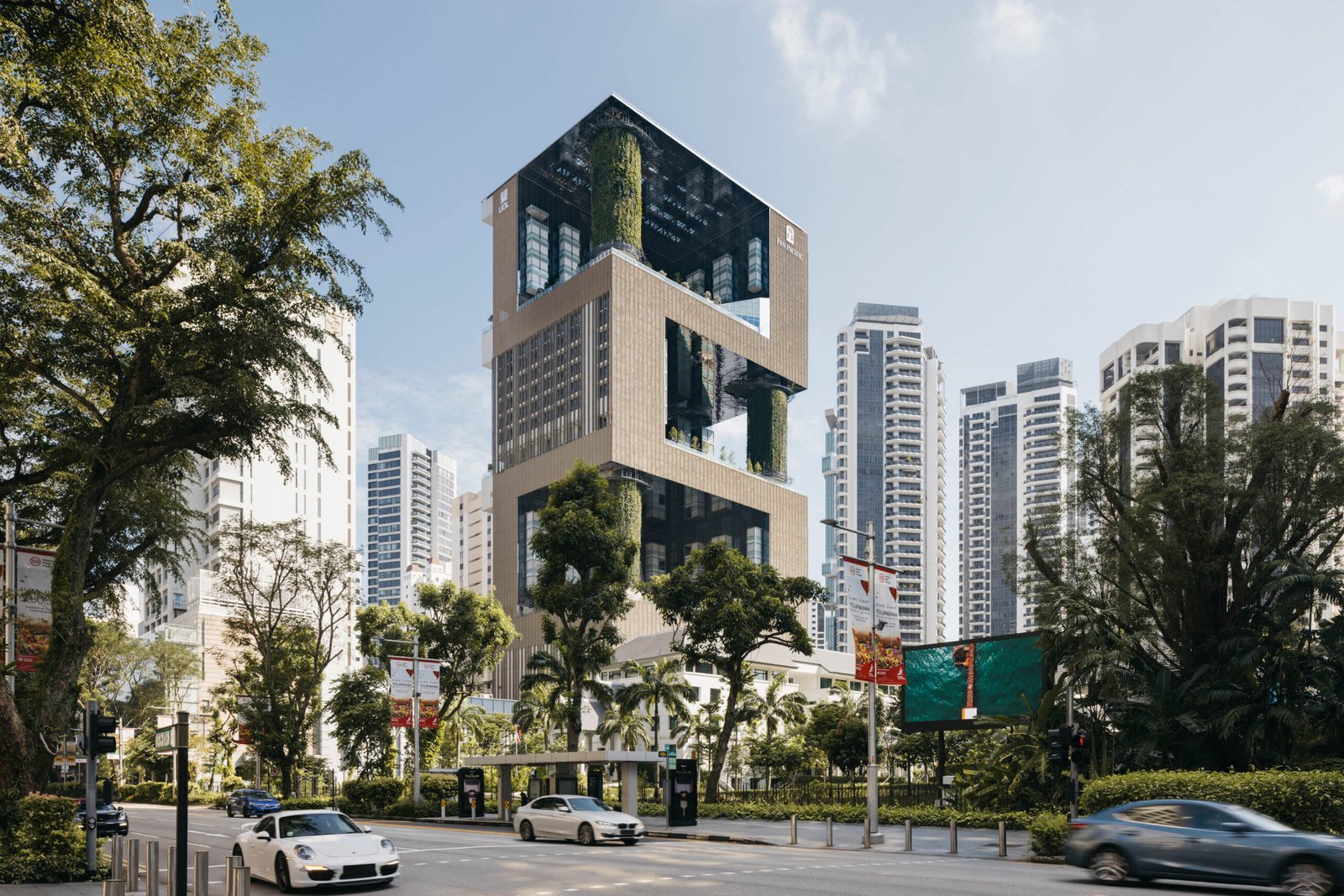Words Patrick Kasingsing
Images Darren Soh and Studio Periphery


As I was craning my neck from the cab as it approached the Pan Pacific Orchard, I could feel a tinge of indifference encroaching on my awe. There is no questioning the hotel’s aesthetic impact—its boxy verticality, easily ungainly in less experienced hands, has found beauty from its designers’ embrace of natural entropy; Verdant greens burst forth with seeming abandon from the tower’s four ‘shelves,’ making for a distinctive silhouette amidst Orchard Road’s crowded skyline.
No, it wasn’t the tower’s looks that bothered me. My indifference stems from the fact that it is but another entry in Singapore’s already rich catalog of environment-friendly skyscrapers, a typology brought about by the island nation’s scarce real estate and sustainability push. Pan Pacific Orchard isn’t even venerable Singapore practice WOHA’s first, or even second foray into tropical hospitality. More sustainable buildings are, of course, more than welcome. Still, I couldn’t help but wonder what would be worth writing about this development that hasn’t already been regurgitated about its lofty green neighbors. Perhaps a night’s stay would reveal an answer?


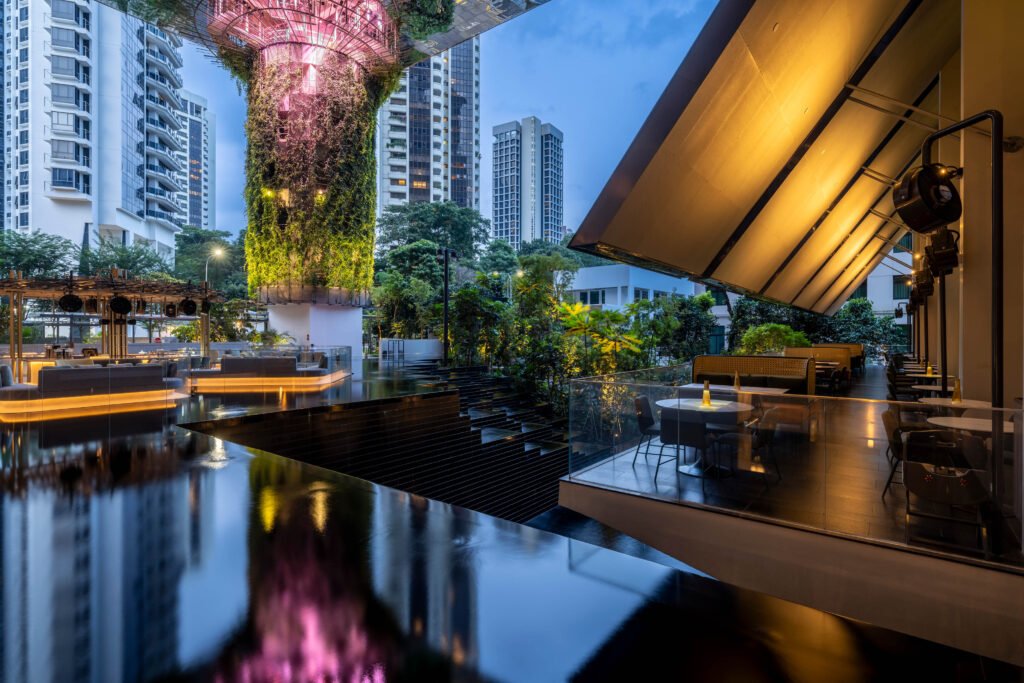

The Pan Pacific Orchard’s façade immediately plants an impression of natural abundance, with four landscaped terraces spanning six-floor stacks carved out of its orthogonal volume. Brown-hued metal screens sheathe the entirety of the tower’s 23-story volume, encouraging the cascades of endemic vegetation creeping along the terraces’ precipices, not unlike the forested ledges of tropical hospitality trendsetter PARKROYAL Collection Pickering and lofty Oasia Hotel, both by WOHA.
While the current belle of the hospitality ball this side of Orchard, the hotel traces its origins back to 2015. WOHA and developer UOL Group conceptualized the hotel as a “new prototype for high-rise tropical hospitality.” WOHA envisioned the building as an embodiment (or a reflection, at the least) of Singapore’s natural environment, likely to remind guests that there’s more to the country than LEED-certified skyscrapers and other man-made structures. The previous iteration of the hotel, which occupied the same lot, was closed for redevelopment in 2018. Pan Pacific Orchard 2.0, with its plethora of sustainability features, cross-ventilation-friendly interiors, and gargantuan open-air terraces, couldn’t have been more prescient as the world emerged from the COVID-19 pandemic when it opened June 2023.
“The hotel typology is changing. It’s no longer just a place to stay; it has become a destination in itself,” WOHA shares. “The impact of COVID-19 has emphasized our connection with nature and its effect on our well-being. Instead of enclosed spaces, the Sky Terraces at Pan Pacific Orchard provide direct access to nature within the city’s density. These open-sided, cross-ventilated spaces offer shelter while adapting to Singapore’s equatorial climate—warm, humid air, low wind speeds, and frequent intense rainfall.”
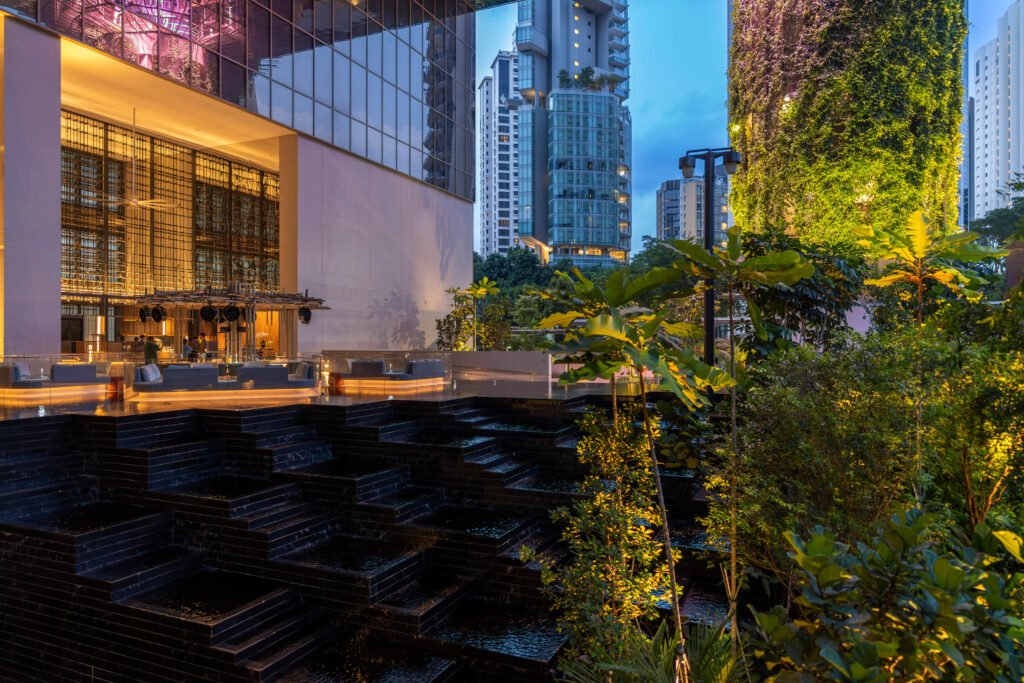

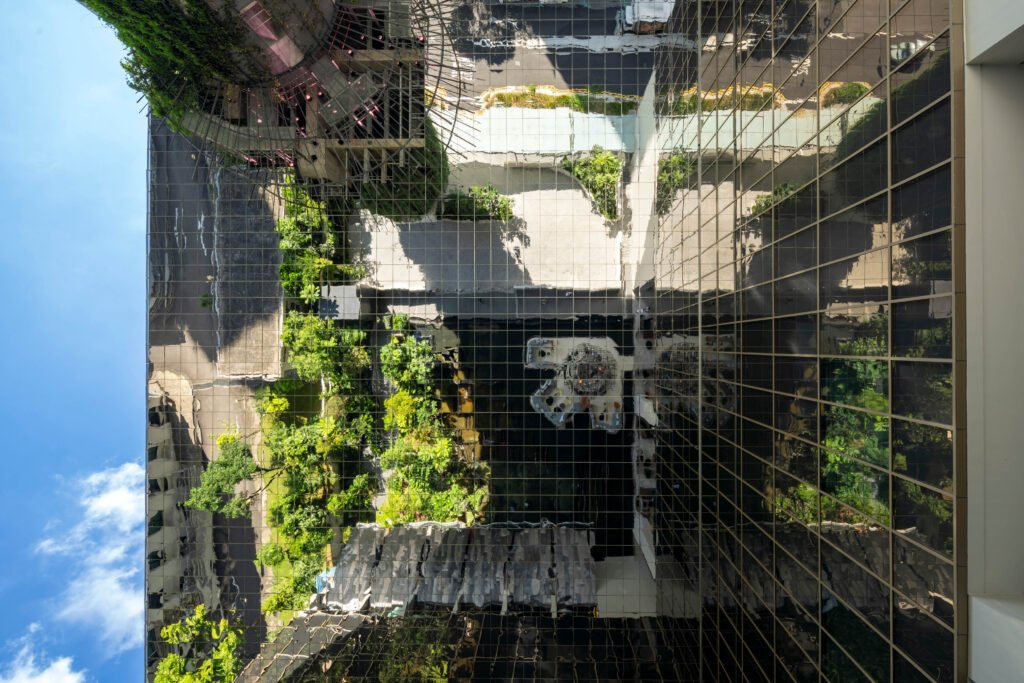

What is also immediately apparent upon approaching the structure is how simultaneously large and svelte it is. Sitting on a modest 3,536 square meter lot, the Pan Pacific Orchard’s shelved form sits lightly on the ground while heightening occupancy targets. The total area yield of the structure is 19,625 square meters. “This unique configuration allowed the designers to play around with the layout and gives the structure an element of surprise,” Teresa Koh, the hotel’s marketing communications director, offered as we went about our tour. “WOHA created opportunities and interest from the development’s constraints and limitations with the building’s S-shaped form.”
Equally admirable was how WOHA imbued the new Pan Pacific Orchard with over 300% more green space despite spatial constraints, thanks to its cavernous terraces. The four landscaped terraces each represent a biome evident in the Singapore landscape—there’s the Forest Terrace on the ground level, the Beach Terrace on level five, the Garden Terrace at level 11, and the Cloud Terrace up on the 18th floor. The flora from these spaces were handpicked to correspond to their respective biomes to heighten guests’ immersion, with each terrace opening to varying views of the city. The colossal ‘pillars’ that hold the S-shaped volumes contain utility staircases and are sheathed in thick foliage, softening their visual impact and contributing to the 11,950 square meters of plant cover created for the hotel. Visually multiplying the bountiful greens and water features are the reflective ceilings that top the terraces, which provide radiant cooling by serving as thermal mirrors. Passersby on street level are treated to the cinematics of all this mirror play, with the activities of the terraces and nearby Claymore Road projected on its perforated surface. From an aesthetic standpoint, the reflective surfaces cleverly mask the considerable girth of the structure by camouflaging the thick terrace slabs.
There is method to the ‘madness’ as to why WOHA distributed the hotel amenities across ‘sky terraces’ instead of consolidating them on a podium deck or near ground level for logistics. The studio explains: “In organizing the building as four ‘precincts’ within a vertical ‘neighborhood,’ the landscaped Sky Terraces provide views for both the guestrooms and neighboring buildings, creating spatial interplay with its context, usually lacking in most high-density environments. By unpacking amenities normally confined within buildings to each Sky Terrace, the activities are revealed and give life and scale to the building.”
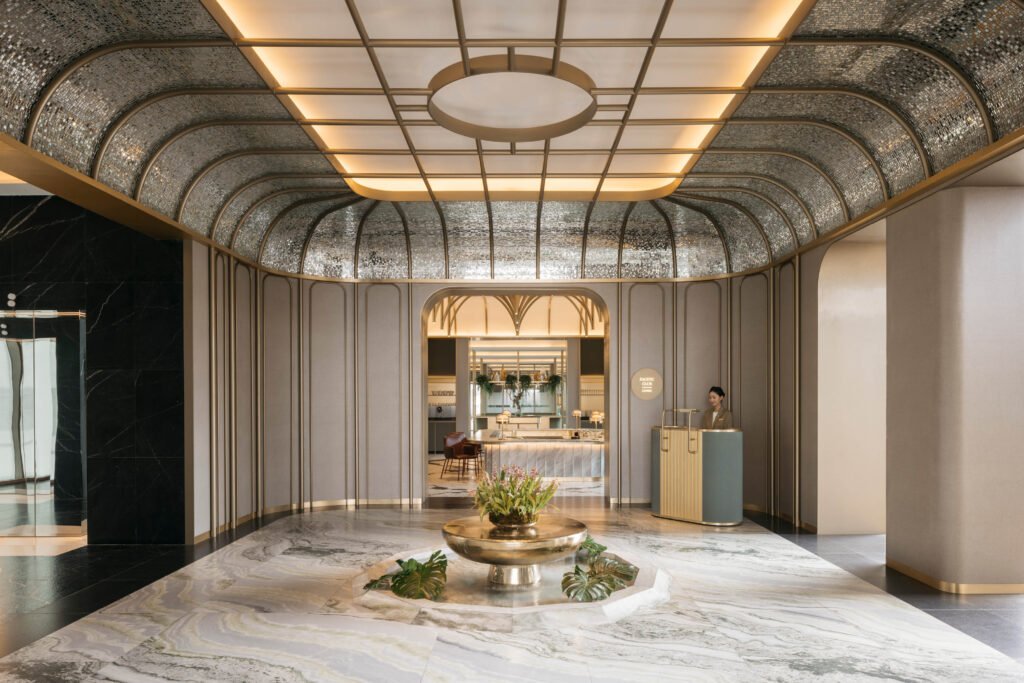
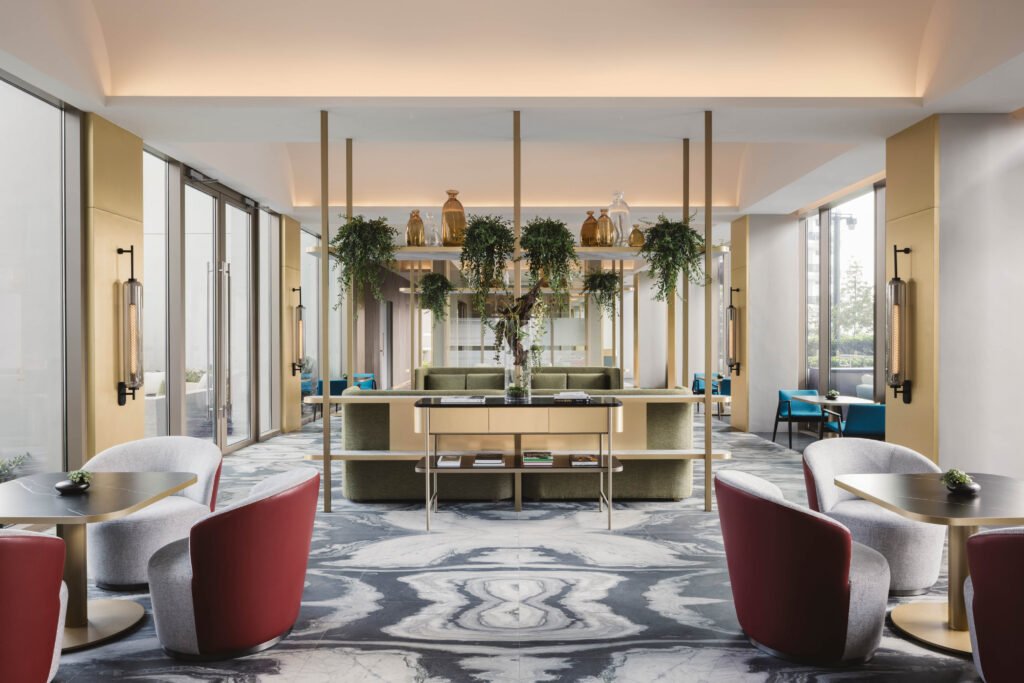


Openness abounds at the Pan Pacific Orchard. Setting foot inside the open-air, double-height lobby at the Forest Terrace, I could already feel the airiness promised by the verdant exteriors, the forest atmosphere further amplified by the sound of rustling leaves and the insistent rush of water from the cascading waterfall beside it. Despite the interior spaces occupying a mere sliver on the ground level, the deft usage of height, the decision to keep the spaces open to the outdoors, and WOHA’s strategic usage of linework visually expand the space. It all makes for a surprisingly breezy welcome to guests, who were probably used to the cocooned, opulent welcome they traditionally receive in five-star hotels. At the Pan Pacific Orchard, luxury is communicated by a grandiose sculpting of space and light and a brazen openness that will surely shock the conservative hotel guest.
Within, the service corridors, elevators, and common spaces like the Pacific Club Lounge and oyster bar Florette are not spared WOHA’s manic attention to detail. Whereas openness as space is communicated through height and straight lines, openness as a value is visually communicated to hotel guests by way of chamfered corners and arches across the interior spaces and furnishings, coupled with earth tones and tropically inspired material finishes, echoing the structure’s rigid, awe-inspiring exterior while also introducing a softness and warmth that speaks of nature’s nurturing side.
The rooms continue the theme of openness with their lack of hard dividers and usage of floor-to-ceiling wall mirrors. The usage of spindle thin-legged furnishings and mirror consoles further adds to the spacious feel the room exudes and echoes the bamboo-like timber inserts that frame the wall mirrors. Each room type is kitted with sustainability features that go beyond your de rigueur hotel room. Low-emissivity glass filters and double-glazed glass mitigate heat buildup within the suites and keep the interior temperature cooler by almost two degrees Celsius. An in-room water filtration dispenser by Swisspro also comes standard within the rooms in lieu of mineral water bottles, allowing me to hydrate to my heart’s content without the guilt of plastic wastage. Welcoming the Singapore breeze is also a possibility with the balcony room types. My Pacific Club room comes with a cantilevered balcony space with a shading system that can open and close to the outdoors (with a smart sensor cleverly shutting off the AC when it senses the shade going up). It was a lovely perch to take in my two-for-one view, with the lush, manicured greens of the Cloud Terrace below, and the commanding Orchard Road skyline in the background.
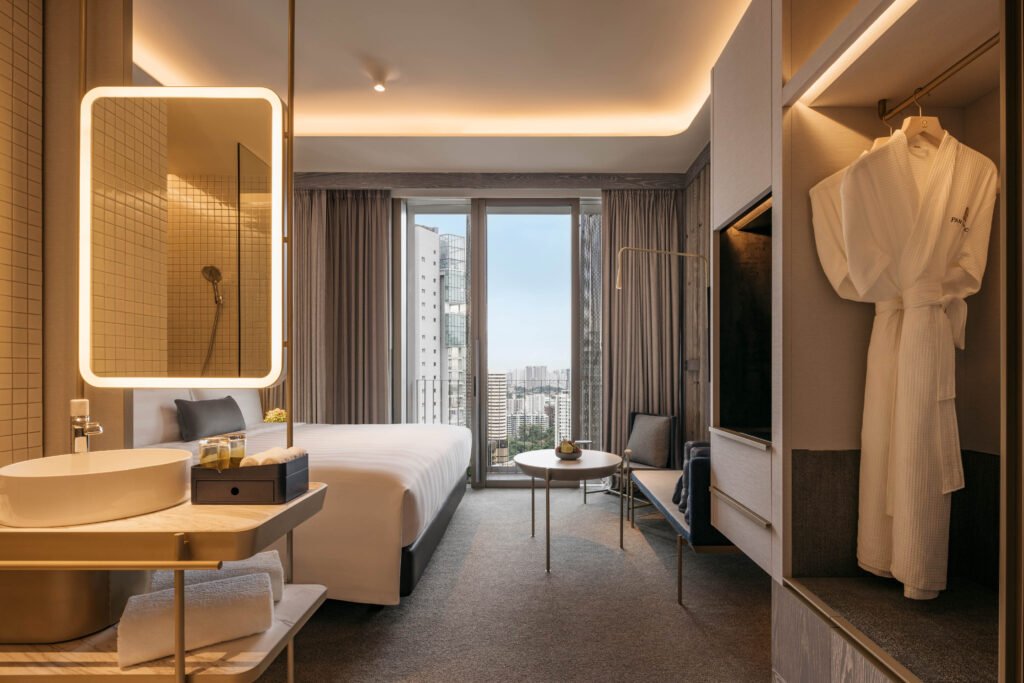


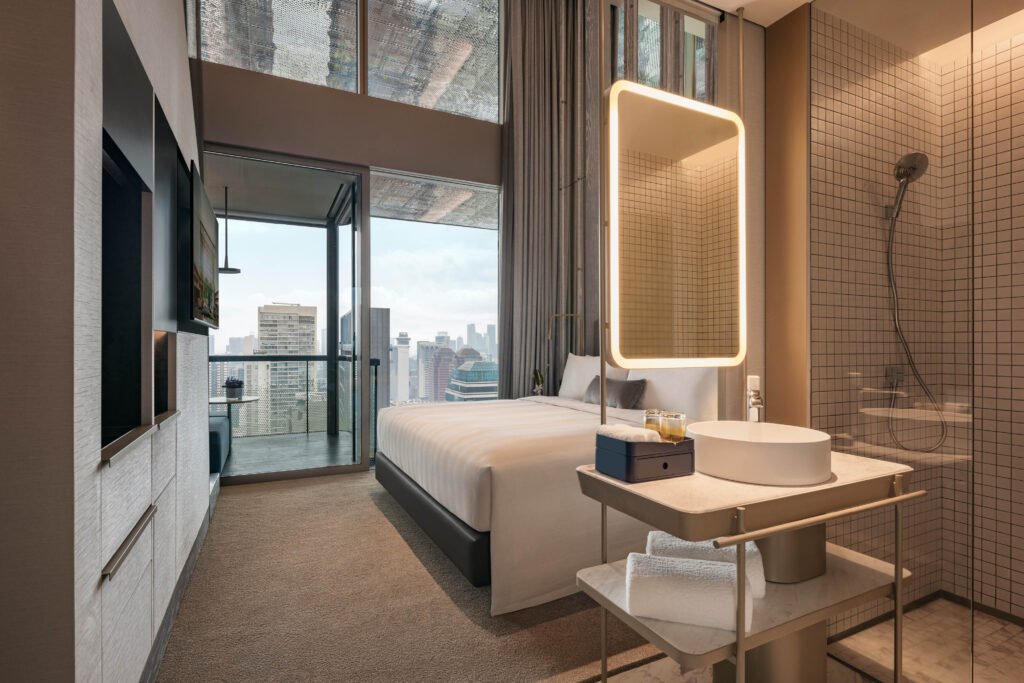
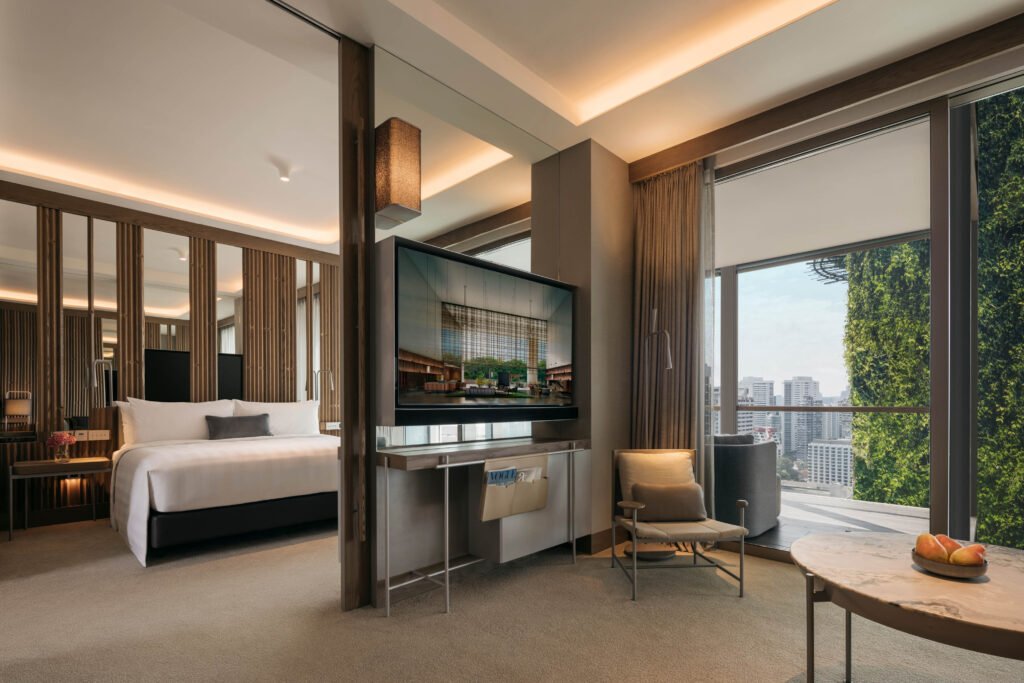
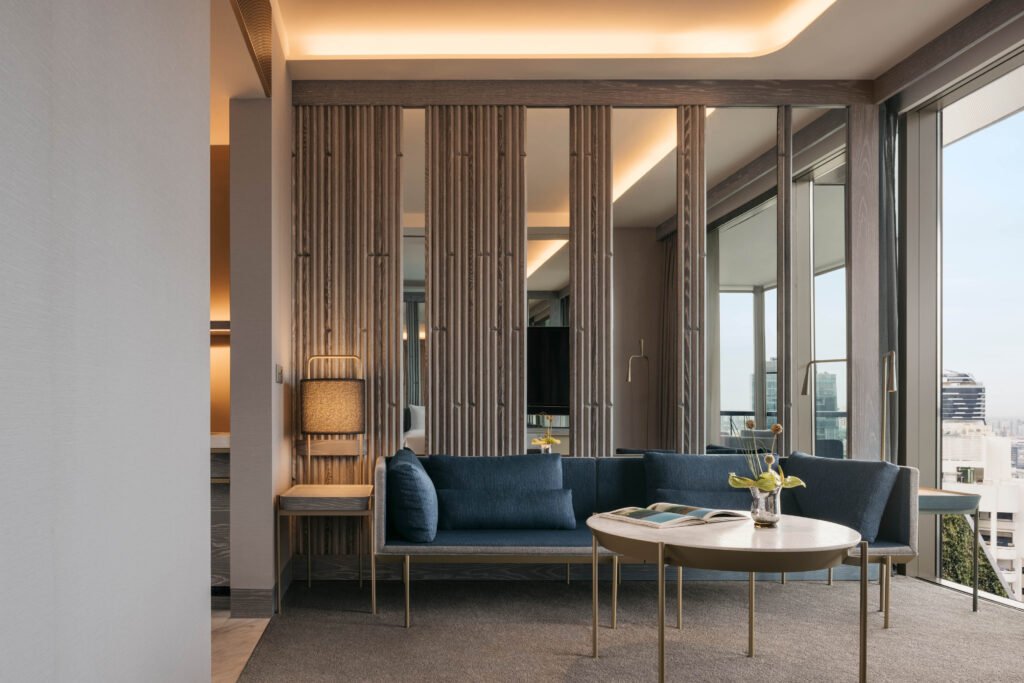
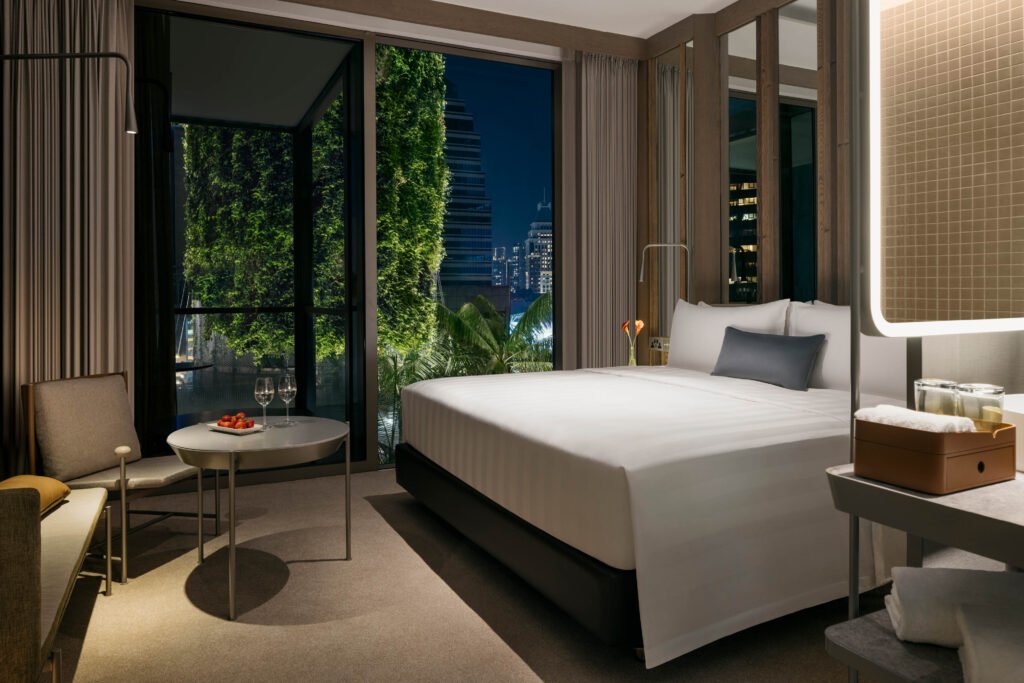
“The impact of COVID-19 has emphasized our connection with nature and its effect on our well-being. Instead of enclosed spaces, the Sky Terraces at Pan Pacific Orchard provide direct access to nature within the city’s density. These open-sided, cross-ventilated spaces offer shelter while adapting to Singapore’s equatorial climate—warm, humid air, low wind speeds, and frequent rainfall.”
W O H A
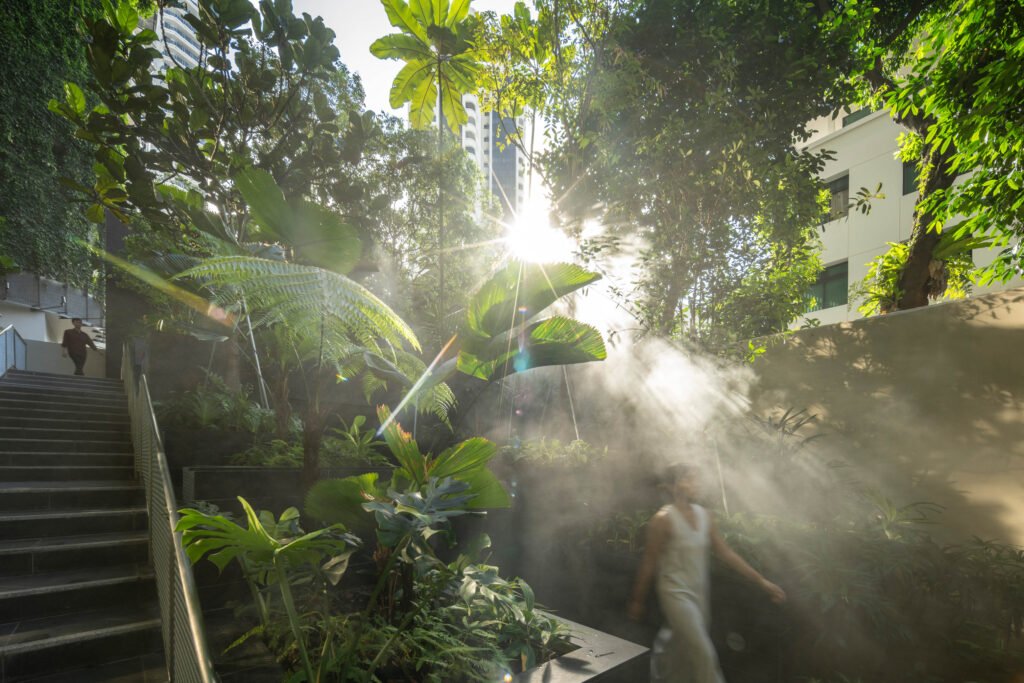

The publicly accessible Claymore-Orchard Road green corridor, photographed by Patrick Kasingsing
The design of each room and amenity space corresponds to the biome that anchors its terrace, further adding to the allure of repeat stays. I felt like stepping into an emerald forest with lush tropical trees and undergrowth on the Forest Terrace, the stepwell-like water feature, and the weave-inspired canopies of signature restaurant Mosella, completing the imagined landscape. The forest-inspired visual palette creeps through to the interiors with forest-green carpeting and wood-hued upholstery for the lobby, with Med-Peruvian joint Mosella painted in warm jungle hues, its angular tiled floor seemingly recalling dappled light on a forest floor.
An admirable gesture by the hotel and its architect, and my favorite feature of the Pan Pacific Orchard is the publicly accessible ‘green corridor that links the quiet of Claymore Road to bustling Orchard Road. Embedded deep into the Forest Terrace and following the hotel lot’s gentle incline, this urban connection makes for a calming and photogenic shortcut. For a moment, the frenetic noise of the city gives way to the soothing sounds of running water from the cascading water plaza, and the murmur of rustling foliage as you progress toward either end. The connection can also be seen as an early tie-up with Singapore’s Urban Redevelopment Authority plan to “bring back the Orchard” in Orchard Road as it metamorphoses into a lush urban green belt in the coming years.




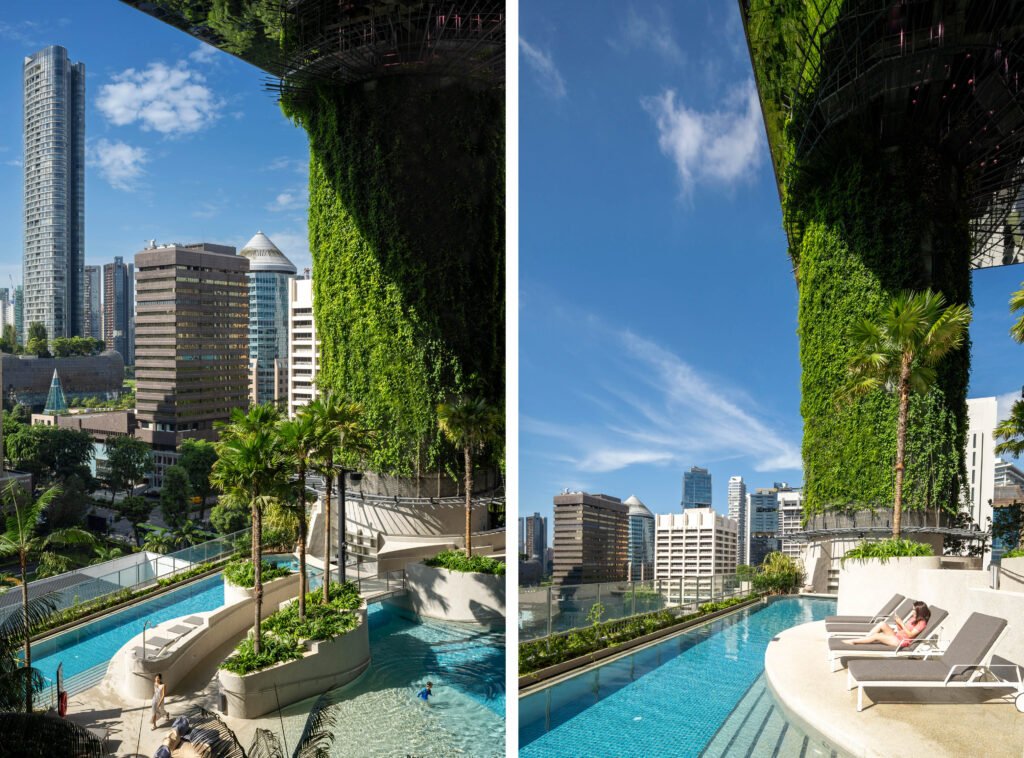

Anchoring the fifth level is the Beach Terrace, a lagoon-like landscape with a pool, sandcastle walls, and palm groves, with its adjacent guest rooms finished in timber paneling, sand-toned hues, and pastel fabrics. Select rooms open directly to the pool deck. “This is the only beach on this side of Orchard,” Koh jests, “…and probably the only one where it’s impossible to get a tan because of the shade!” The Garden Terrace on the 11th lives up to its name with its curated garden and central lawn surrounded by planter beds, seating squares, and water features. The botanical theme is in full bloom in rooms from levels 12 to 16, with marbled finishes, fabrics, and in-room accessories in vibrant shades of green. The topmost Cloud Terrace on the 18th floor represents the modernity of Singapore’s ever-growing skyline, with its silver-hued plantings, perforated ceiling, and reflecting pools. The surrounding rooms follow the silver-white theme, recalling light, pristine clouds.
The Pan Pacific Orchard makes a bet on its unorthodox placement of public event spaces on the highest terrace of the hotel. The architect intended to distribute activity areas, amenities, and rooms across six-story stacks to create multiple landmarks within the hotel’s vertical neighborhood. And it appears that the hotel’s gamble is paying off: the event terrace was abuzz with meetings during my visit, with a lavish wedding reception set to unfold at the hotel’s prime venue, the 500 pax, 600-square-meter Claymore Ballroom come evening.
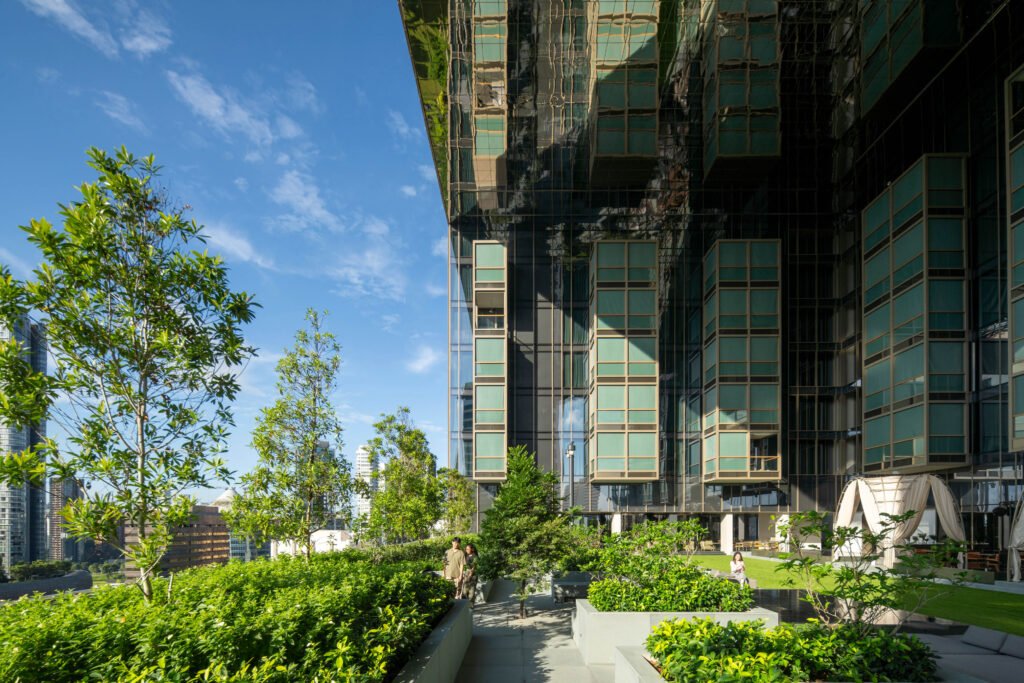
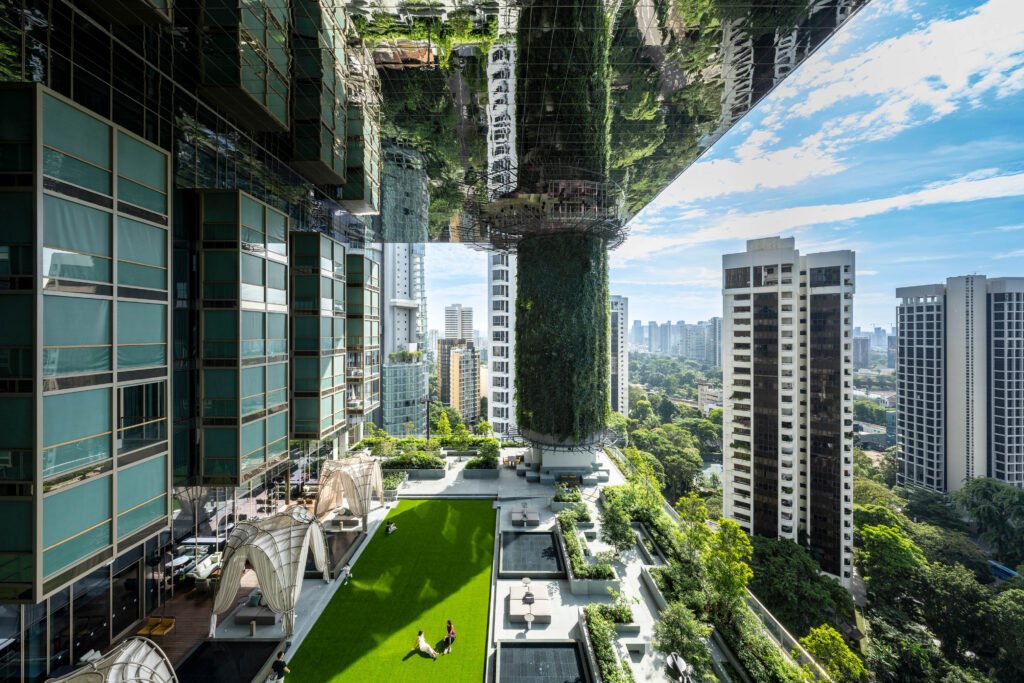
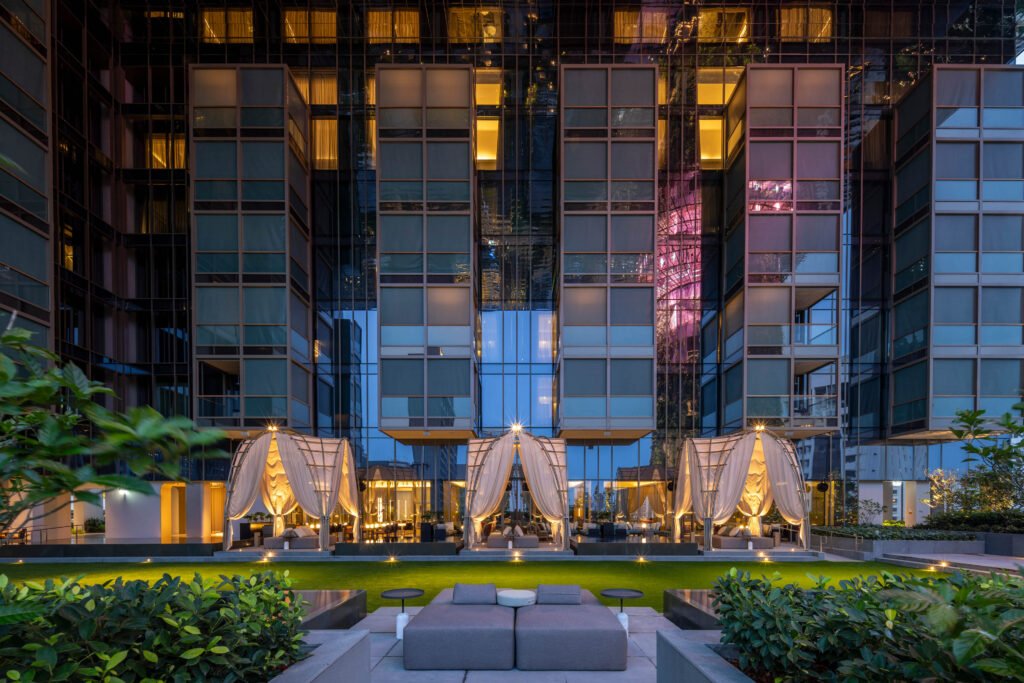


“The architect intended to distribute activity areas, amenities, and rooms across six-story stacks to create multiple landmarks within the hotel’s vertical neighborhood.”




While the four biomes making up the Pan Pacific Orchard offer different experiences, they are tied together by a laundry list of sustainable features that deservedly earned the hotel its Green Mark Platinum rating, with LEED certification underway. The terrace designs are optimized for cross-ventilation and self-shading, lessening the energy needs of the building. Cost-efficient misting fans provide additional cooling in outdoor areas on days of swelter. Maintenance for the flora in each terrace is achieved through a sophisticated rainwater harvesting system for irrigation. Rounding out the hotel’s green technology are 360 photovoltaic panels on the roof that generate clean energy and a bio-digester system that converts food waste into cleaning water.
Yet, despite the bevy of eco-features and its impressive attempts to reflect Singapore’s natural landscapes through architecture, what the Pan Pacific Orchard managed to awaken in me is a pining for the natural. There is simply no replacing a thriving forest, a pristine beach, or a flourishing garden. WOHA echoes this sentiment: “The lush landscaping of the Sky Terraces offers a green escape from urban sprawl, reflecting our belief in the coexistence of the built environment with nature for true livability, responsibility, and sustainability.”
By threading the line between what’s real and manufactured, the hotel appears to state that preserving nature is paramount and that no man or architectural landmark can ever replicate what nature so generously provides. The effort, however, is more than commendable for WOHA and the new Pan Pacific Orchard. •


